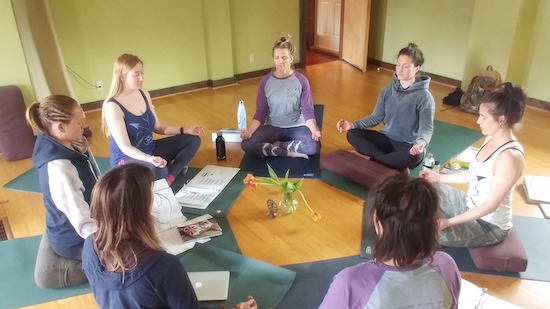
I completed my Teacher Training in 1997—and back then, the programs for getting certified were naturally a little bit smaller.
Now, with the rise of interest in teaching yoga—as well as students who wish to deepen their knowledge—Yoga Teacher Trainings are exploding.
They are everywhere, and they are churning out big numbers of new teachers. Unfortunately, with that bigger quantity, inevitably, the quality of those larger programs diminishes.
Since my training, I have attended two more programs, simply out of interest and also to advance my learning to the 500-hour level. Each time, I’ve had the same thought: How can anyone leave this program, as one of 50 or a 100 students, and genuinely feel ready to teach?
Maybe it’s me. Maybe I need more time, more feedback, more give-and-take with my teacher, but the idea of leaving one of the larger groups getting certified and feeling that I can face a class and teach it safely, or with confidence, or that I have found my voice seems unlikely.
Here are 10 reasons why I feel like a smaller-sized program is so important:
1. Each student gets noticed: In a smaller class, it’s more difficult for students to hide and get left behind. Fewer students means that each one gets attention from the teacher, and they are encouraged and pushed to take part and express their opinions. No one slips through the cracks
2. Better results: Research has shown that students in smaller classes do better in whatever they are certifying in and perform better on their exams in general. In Yoga Teacher Training, that translates to a student emerging as a better teacher, more capable, and more confident.
3. Learning is Enhanced: Not only do students learn more in small classes, they also learn faster. And this means the class progresses through the course material more quickly. We are able to move through a more basic understanding of yoga history and apply that learning to daily life. For example, in Essential’s Program, we not only learn about the Yoga Sutras, but we discuss how they are relevant right now, to current life. Student’s learning is enhanced by the confidence students develop to share their opinions and ask and answer questions, which also benefits their peers.
4. Teachers can teach: Teachers leading a smaller group have more opportunities to observe and assess the class as a whole—and the students as individuals. Learning is further enhanced when teachers and students can interact spontaneously in the classroom. This happens all the time in Essential’s program. The program shifts and melds to fit who the students are in that particular program rather than holding steadfast to one “cookie cutter” dimension.
5. Classes become a community: With fewer students per class, individuals can connect more closely with their peers and become more confident and comfortable when it comes to sharing their ideas and perspectives. These connections lead to lasting friendships. In our program, students will respect and connect with peers who are from all over, which leads to meaningful friendships and a huge network of people to connect with––a skill that is very important in the globalized 21st century.
6. Opportunities to participate: Small groups mean fewer voices, and that means the students those voices belong to have more chances to speak up with their questions and their own particular issues. They can apply the knowledge they’ve acquired as they participate in discussions and express their opinions.
7. Focus on learning: In any learning environment with a limited number of students, teachers can spend more time teaching the material and less time distracted with side stories and dramas. Our teachers cater to students’ different learning styles and ensure that they understand what is being taught in a way that is meaningful to them.
8. More feedback: Teachers have more time to individualize their feedback, ensuring that each student understands the material, gets the help he or she needs, and is finding his or her voice as a teacher.
9. Students and teachers can work one-on-one: In smaller groups, students and teachers can often work together one-on-one, which gives teachers the opportunity to customize guidance to the particular needs of the students, and the students receive their instructors’ and mentors’ undivided attention.
10. Ideas are shared: With fewer students in a class, there is more time for them to share their own ideas, express their opinions, and describe their perspectives and where these come from—all of which enrich everyone’s experience of what is being learned.
~
~
~
Author: Francesca ter Poorten
Image: Author’s Own
Editor: Travis May










Read 0 comments and reply